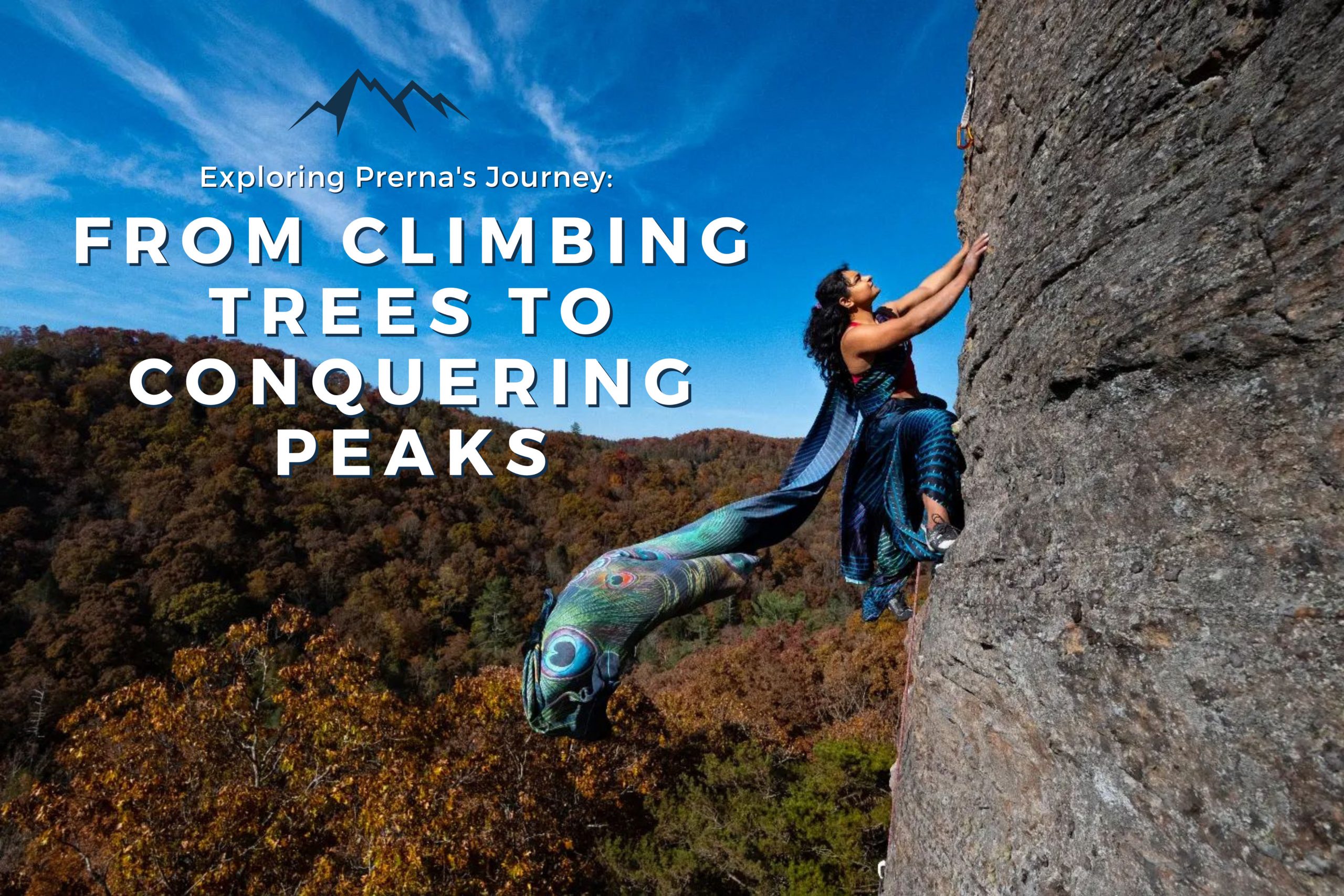
Have you ever marveled at the majesty of a towering mountain, pondering the exhilarating challenge of conquering its lofty peaks?
As we dive into this interview, you’ll discover that the realm of climbing extends far beyond merely scaling nature’s monumental citadels. It’s a thrilling expedition of defying limits, vanquishing apprehensions, and testing your physical and mental mettle.
Prerna’s narrative unfurls, offering a distinct viewpoint on the climbing universe, where the quest for the most efficient ascent remains a perpetual battle, and the largest handholds stand as emblems of victory.
Within this conversation, we explore the awe-inspiring odyssey of Prerna Dangi, an extraordinary climber who transitioned from scaling village trees to triumphing over colossal summits. Her tale serves as a testament to the notion that climbing isn’t just a pastime—it’s a way of life. It embodies a ceaseless pursuit of self-enhancement, resilience, and the audacity to shatter the boundaries of one’s comfort zone.
Table of Contents
Interview:
Prerna’s Climbing Experiences
Yuktie starts the conversation by asking Prerna how she first got into climbing.
Prerna: “I think with climbing trees in my village. You know, As somebody who was not a climber. Who did not know that climbing was a sport? I was just an active kid who would climb the doorframe, and trees in my village.” Prerna shares that these early tree-climbing adventures were the starting point of her climbing journey. And she gradually delved deeper into the sport.
For Prerna, the journey from tree-climbing to conquering mountains was gradual. She recounts how, during her college years, she stumbled upon a picture of a climbing wall that piqued her interest.
Being naturally inclined towards sports, she had engaged in traditional activities like basketball, badminton, and kho kho, which are popular traditional Indian sports. Yet, she longed for something more, something that would challenge her physical strength and spirit.
Yuktie resonates with her story, who, as a child, struggled with physical education but now finds it hard to believe that others might see her as anything but physically fit.
“I feel like I’ve made the outdoors my comfort zone,” Prerna exclaims.
She goes on to reveal her fear of other people’s comfort zones, such as acing a corporate meeting. Prerna believes there are many ways to break free from one’s comfort zone, and once you conquer the physical barriers, it’s the mental ones you have to push through.
“It never gets easy,” she reiterates when asked about climbing. And with that, Prerna’s gripping journey through the world of climbing continues, where each ascent brings new challenges and rewards.
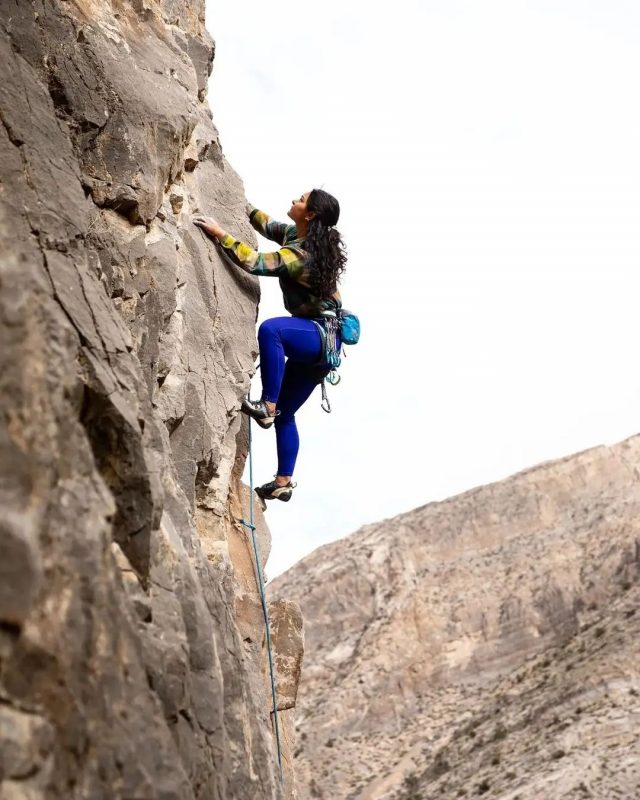
Capturing Prerna in action as she scales a rock. (PC: thepahadigirl)
Prerna’s Perspective on Climbing: Seeking the Easiest Way to Ascend
Climbing, as Prerna explains, is a constant challenge that keeps her coming back to square one, even in front of familiar rock faces. While she no longer feels like a novice, the essence of the challenge remains unchanged.
Yuktie empathizes, acknowledging that climbing is a relentless pursuit. It demands a constant, unwavering effort. Climbers grip rocks with just a finger or two, balance precariously on the tips of their toes, and rely on their upper body strength, agility, and flexibility.
Prerna interjects, highlighting a different perspective. She explains that while people may envision climbers defying gravity with daring feats, in reality, she’s often just searching for the biggest holds to grip onto.
Prerna explains: “I think we constantly look at climbing like, ‘What’s the hardest point in this thing?’ and we imagine that.”
She points out that only a small percentage of climbers are pushing the extreme boundaries of the sport. For her, the fun lies in finding the easiest way to ascend and making the most of each movement.
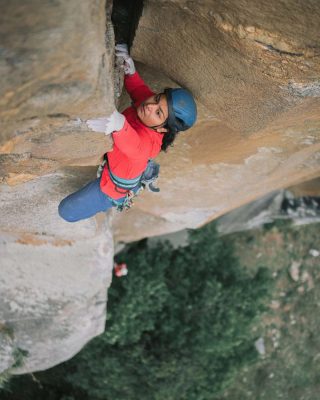
Prerna testing her grip on the rock edge. (PC: thepahadigirl)
Overcoming Challenges in the World of Climbing
Yuktie then shifts the conversation to the challenges Prerna has encountered along her journey.
Prerna: “Climbing is obviously a newer sport in India.”
She acknowledges that there have been obstacles. Many individuals in India don’t know where to seek mentorship or assistance. However, Prerna highlights the emergence of micro-communities dedicated to the sport, making it more accessible for newcomers.
Prerna recognizes that the sport can be demanding and often requires substantial resources in terms of time, money, and equipment. For many with 9-to-5 jobs, it remains a privileged pursuit.
Prerna: “I think what these communities have taught me is that in whatever capacity, you can still try to pursue this sport.”
She emphasizes the importance of finding creative ways to overcome these barriers, especially when climbing solo.
Read more: Discussing Packing, Sustainability, And Community Building With Samriddh Burman
One of Prerna’s significant challenges was finding like-minded climbing partners who shared her aspirations. She initially climbed with male friends, being the only woman in the group. Over time, her desire to climb with women grew stronger.
Prerna: “I wanted to do rock climbing, mountaineering, ice climbing, and put it all together in one tough Himalayan expedition. I spent a lot of time climbing with my male friends. Until I realized I wanted to climb more with women.”
She says that climbing with women is something that she has been intentionally moving towards. She wanted to become independent in the sport. Once she mastered the necessary skills to climb independently, which was a lengthy process, her struggles helped her grow and adapt. She cherishes the challenges she faced and believes they shaped her.
Prerna also acknowledges the societal perceptions and stigmas associated with climbing. She notes that society’s expectations, combined with personal insecurities, can place a heavier burden on female climbers compared to their male counterparts.
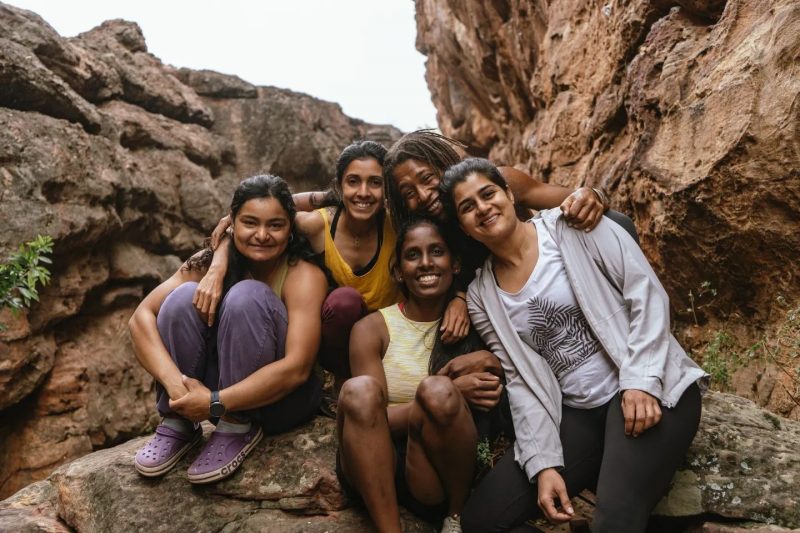
“From a handful to a thriving force!” ~ @climblikeawoman (PC: thepahadigirl)
From Climbing Enthusiast to Empowering Women through CLAW
Yuktie, ever the inquisitive interviewer, delves into the story of CLAW (Climb Like A Woman), a gathering initiated by Prerna herself. Prerna explains that CLAW began as a means to connect with women who shared her enthusiasm for outdoor activities, particularly climbing.
She, along with her long-term climbing partner Vrinda, had developed a strong bond while training and climbing together. They had become so accustomed to each other’s company that it felt empowering to embark on their climbing journey to Badami as a duo.
Prerna recalls: “I felt so empowered to just be out with another female partner on our own climbing trip,” It was during this trip that they had the serendipitous opportunity to meet Rekha, Gauri, and eventually Mel, adding more inspiring women to their circle.
CLAW, initially conceived as a way to create a space for women climbers in India, evolved into a broader community. Prerna emphasizes that their primary motivation was to climb together as women, sharing their love for the sport. She likens it to the way people meet and bond over shared interests in a club or a restaurant. In this case, it was about providing a platform for Indian women who aspired to climb.
As the group grew, CLAW expanded its mission to encompass resource gathering and funding for grants, to make climbing more accessible to women and girls. Prerna’s vision for the community is rooted in inclusivity, reaching out to those who might otherwise be unable to access the sport.
Prerna’s commitment to CLAW (Climb Like A Woman) goes beyond simply encouraging women to climb; it’s about empowering them. She confesses that she once found the word “empowerment” to be somewhat overused.
However, witnessing women who had never climbed before, who had never moved their bodies in such a way, enter the world of outdoor climbing and express astonishment, saying things like, “I never thought I could do this,” was a revelation for her. When around 15 women shared these sentiments, it left a profound impact on her.
Yuktie relates her introduction to climbing, which happened through a gym membership that included access to a climbing wall. She describes the initial exhilaration of reaching the top and ringing the bell after several days of practice.
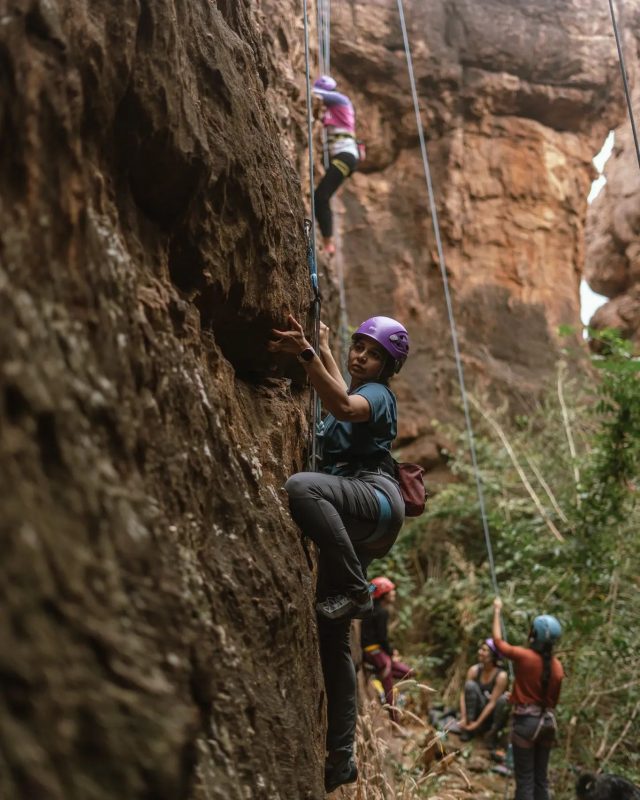
“Climb like a woman and conquer like a boss.” (PC : climblikeawoman)
Exploring Climbing Culture and Conquering El Capitan
Moving on, Yuktie inquires about Prerna’s experiences during her trip to the United States and the climbs she undertook there.
Prerna enthusiastically dives into her journey, sharing that she spent roughly four and a half months exploring climbing locations in the US. Her main motivation was to undertake certification courses with organizations she admires. She points out the lack of standardization in India and the abundance of accessible rock climbing in the US. The contrast was eye-opening, as climbing is a much larger sport in the US, making it a rich experience of climbing culture and history.
Prerna: “I climbed in Colorado, Washington, I was coming to the north cascades, then I went to California and went to the eastern side to El Cap.” She reflects on her awe-inspiring experience at El Capitan, expressing amazement at what humans are capable of achieving there.
Yuktie intervenes, intrigued by El Capitan’s legacy, and asks Prerna to share more about this iconic climbing destination. Prerna obliges, describing El Capitan, often referred to as El Cap, as one of the world’s most prominent vertical faces.
Located in Yosemite National Park, which is renowned for its stunning landscapes and granite domes, it has a historical significance dating back to John Muir’s exploration. In modern times, it has evolved into a climber’s pilgrimage or mecca, captivating the climbing community and travelers alike with its sheer beauty and challenge.
Prerna: “Before I went there, I thought you know like, what’s the big deal? It’s just a climbing spot.”
Prerna reflects on her initial skepticism about El Capitan. She had questioned her friend, not understanding what all the fuss was about, but he insisted that she needed to experience it herself. And so she did.
El Capitan left an indelible mark on her, as she marveled at the accomplishments of climbers from bygone eras, considering their feats both unimaginable and commendable.
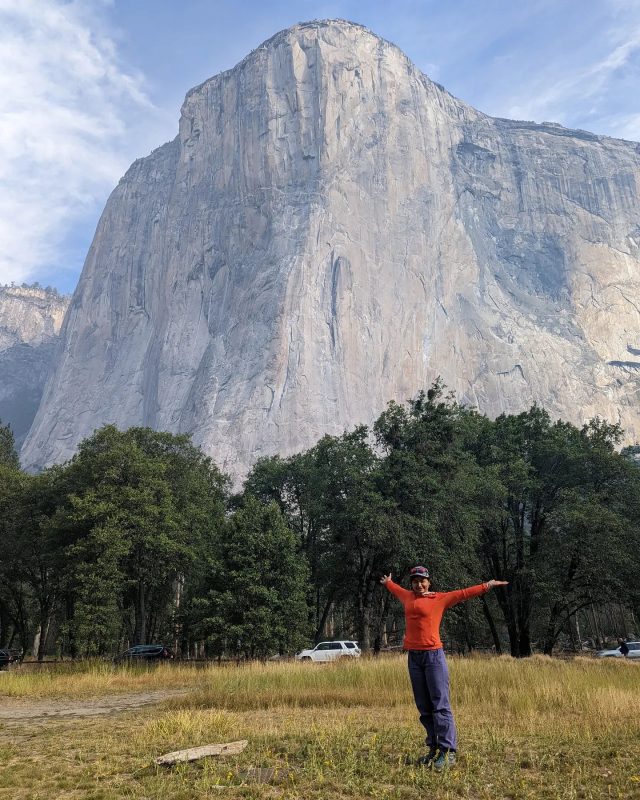
Climbing El Capitan: Where vertical challenges become triumphant horizons. ‘(PC: thepahadigirl)
Prerna’s Winter Adventure Plans with Piti-Dharr Ice Climbing
Yuktie shifts the conversation toward the future, asking about Prerna’s plans for the upcoming winter and the New Year season.
Prerna eagerly shares “The winter season always takes me to the north, to Himachal Pradesh, for ice climbing with my team, Piti-Dharr Ice Climbing.”
Piti-Dharr is on a mission to introduce more people to the world of ice climbing, despite its intimidating nature and the challenges associated with equipment and training. They plan to explore the most beautiful destinations, like the Lahaul Valley, which is accessible by road during winter.
Prerna explains that ice climbing involves scaling frozen water bodies, essentially climbing the structures formed by frozen waterfalls, using ice axes and crampons. She’s cherishing the last few warm days in the south before heading north for the winter adventure.
Yuktie praises the plan and inquires about the dates for those interested in joining their ice-climbing adventures.
Prerna reveals that they have a beginner’s course scheduled for the middle of January and directs people to Piti-Dharr’s Instagram page (@pitidharr) for more information. They have several batches to accommodate participants. Keylong, not far from Manali, is a great place to get introduced to ice climbing, while Spiti, though a longer drive, hosts an ice festival for those who have already gained some experience. In Lahaul, they’re focused on training and expanding their ice-climbing community.
View this post on Instagram
Conclusion
As we wrap up this interview, we’d like to share some valuable insights from our conversation with Prerna, whether you’re an experienced climber or someone considering this adventurous journey. Here are a few key takeaways:
First and foremost, when it comes to climbing, make sure your shoes are securely fastened to maintain a strong grip, and carefully choose your clothing to stay dry and warm, especially when you’re halfway through your ascent.
If you’re eager to delve into the world of climbing or connect with like-minded women in the community, consider exploring CLAW (Climb Like A Woman). You can discover more about their activities and initiatives on their Instagram page.
We hope this enlightening conversation has offered you valuable insights, from climbing tips to personal experiences, highlighting the sheer determination required to overcome both physical and mental challenges. Climbing, much like life, is about pushing your limits and uncovering your true capabilities.
If you’re interested in watching the full interview with Prerna Dangi, the passionate climber and co-founder of CLAW, you can find the link below. We trust that this conversation has left you inspired and ready to embark on your own adventures, whether in the realm of climbing or any other pursuit that both challenges and excites you. Until next time, stay curious and keep exploring.
This blog article is written by Kosha Team Member – Kauravki Bansode